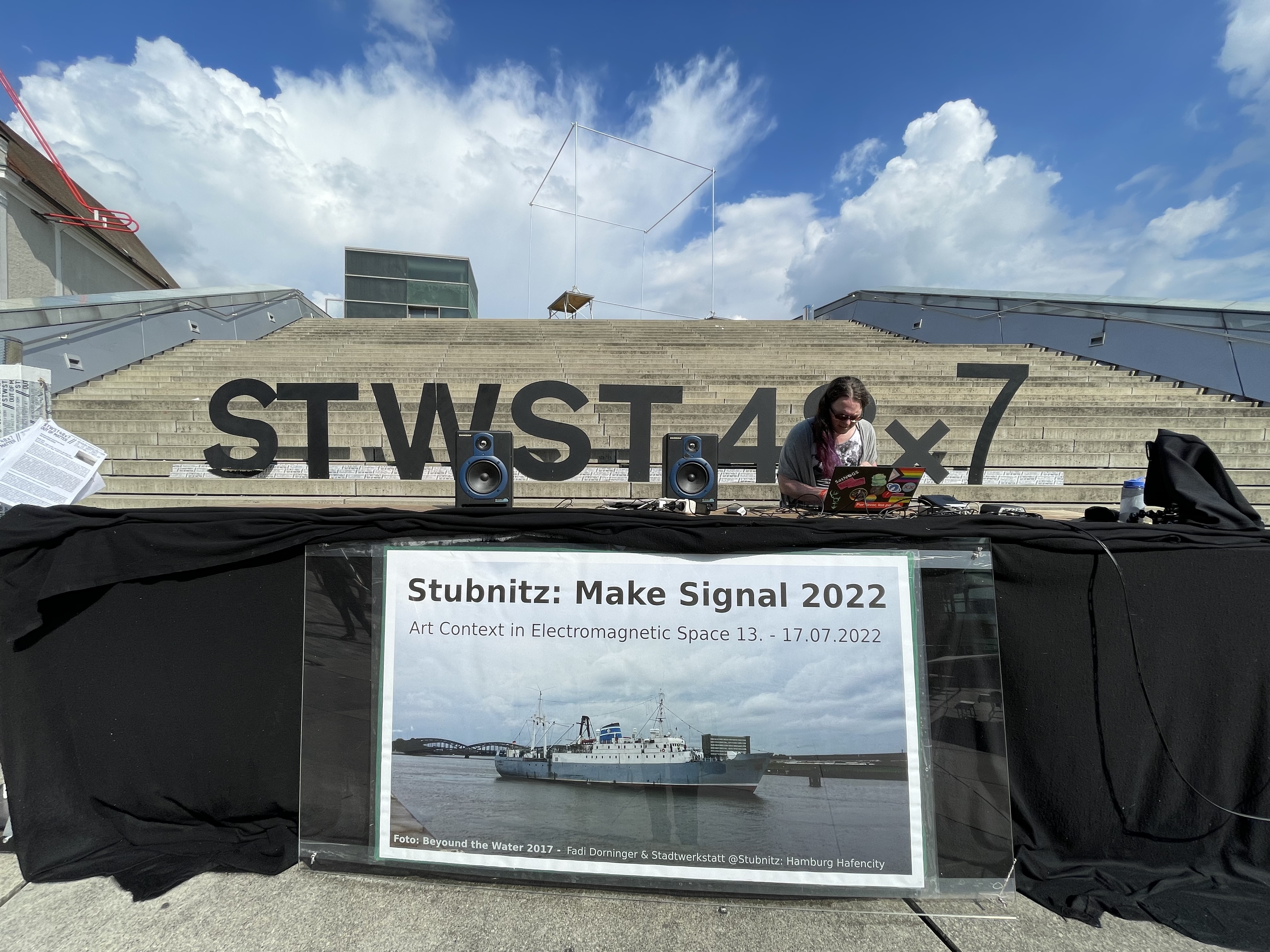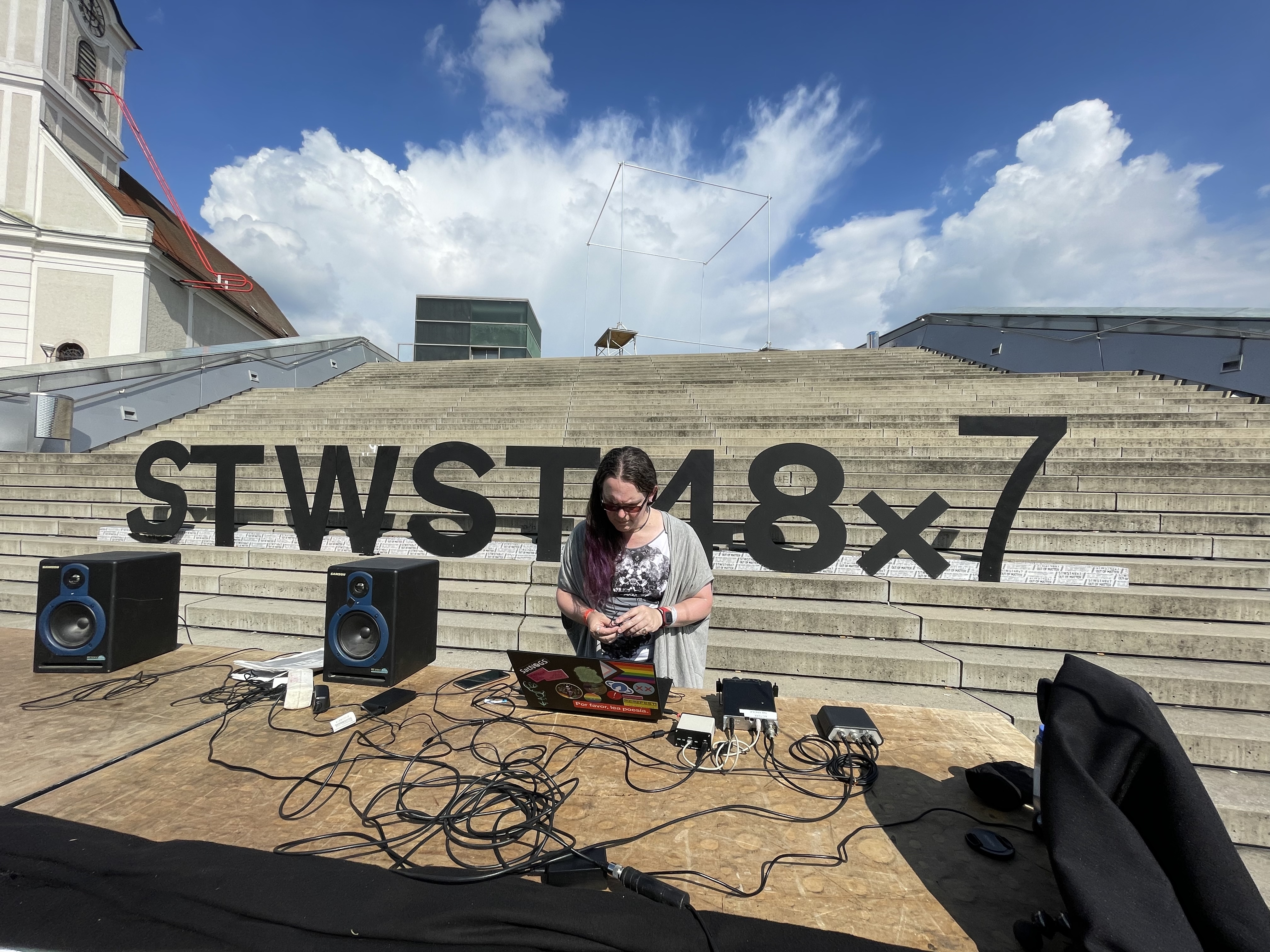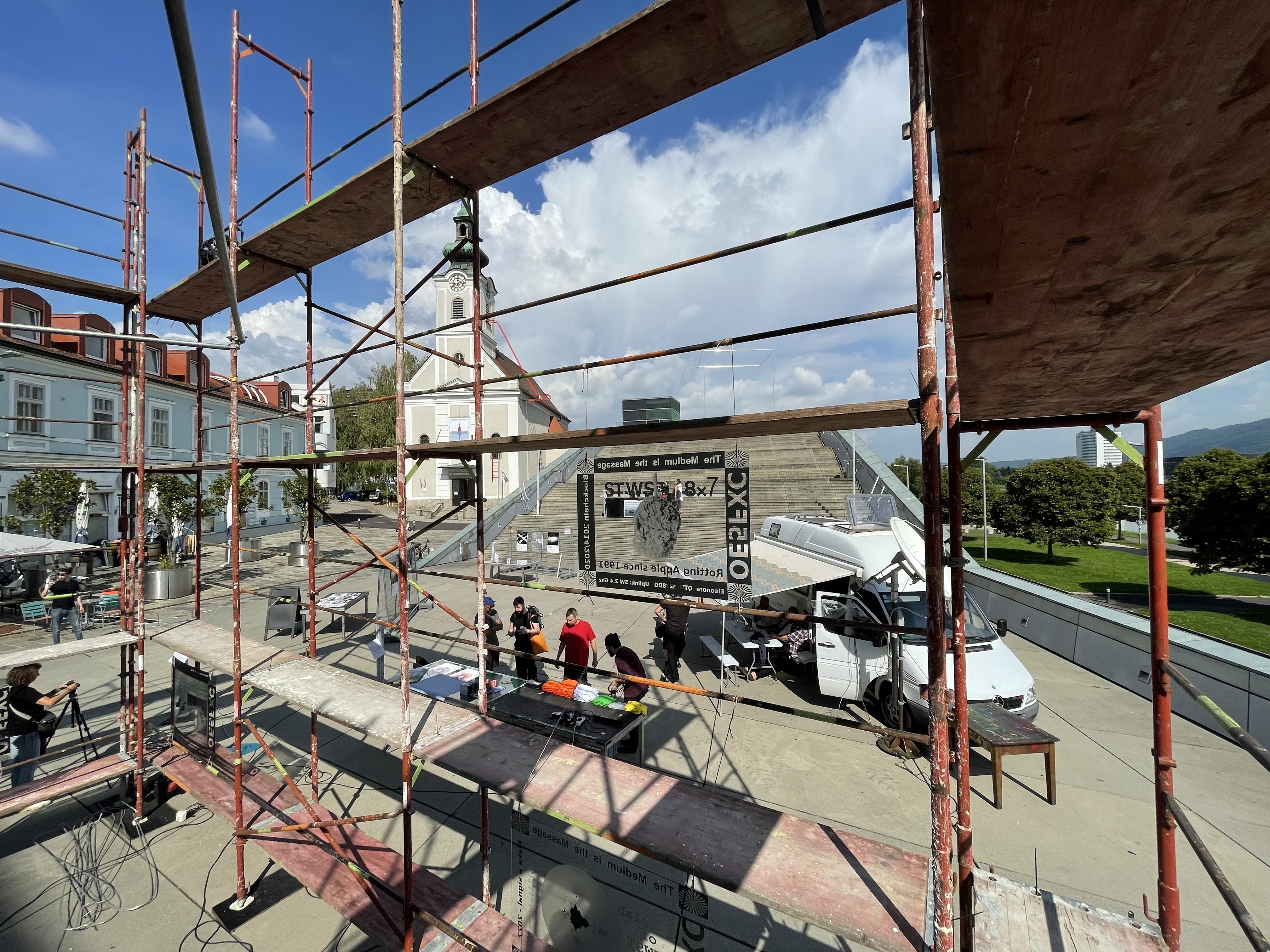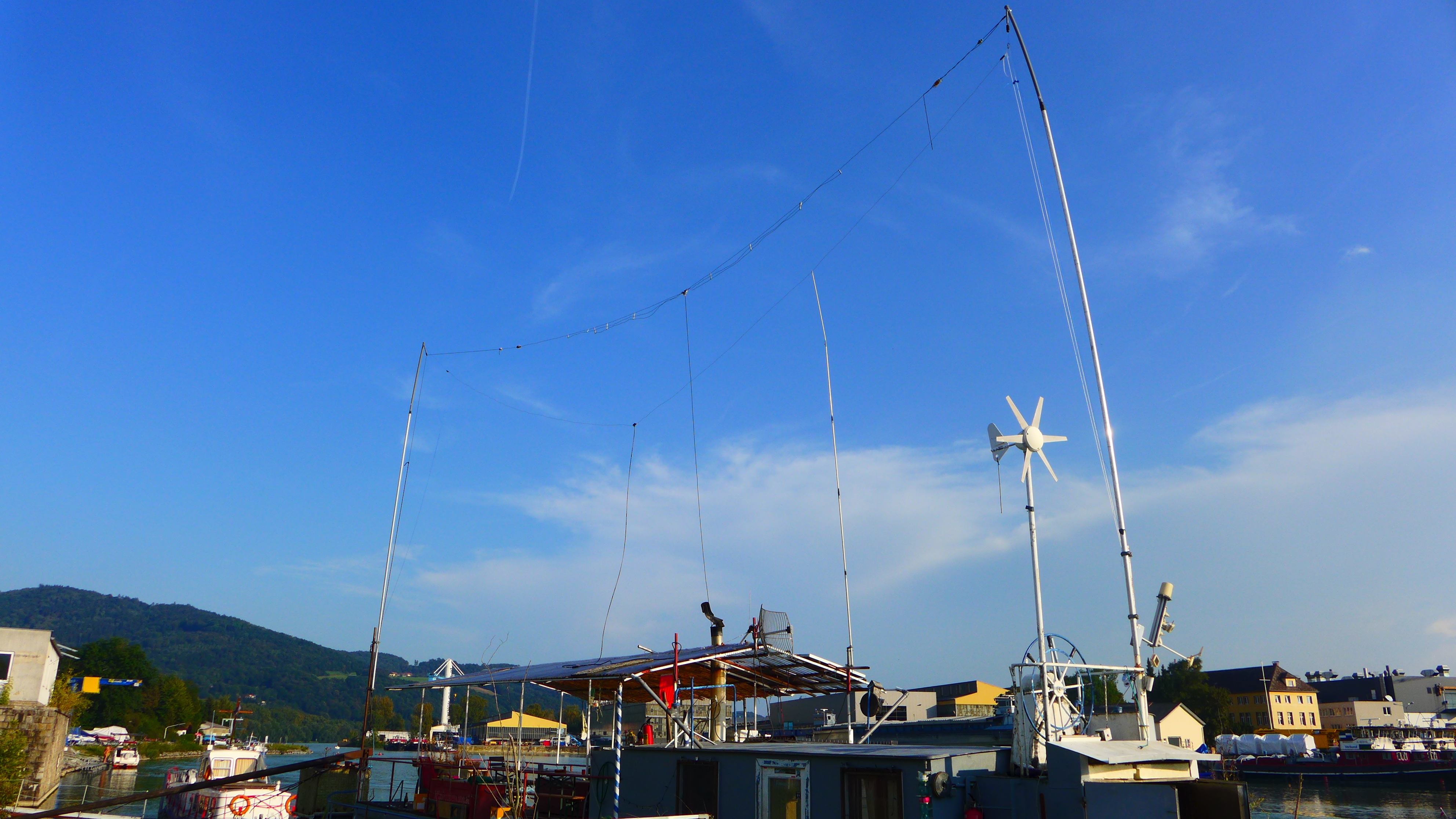
MAKE ME A SIGNAL
Prelude to a RADIOTOPIA
12 Radio Artists
Live-Radio-Station on Maindeck, STWST
and Radio Streams via Radio FRO Linz and ∏Node Paris
both on fro.at and p-node.org: Sun, 12. Sept, 14:00 – 18:00
Organized by Shu Lea Cheang, Adriana Knouf, Franz Xaver
in preparation for Radiotopia, a RadioNet summit at STUBNITZ, Hamburg, July 13-17, 2022
Since 2009, the Messschiff Eleonore, once a survey vessel, has been docked at the Danube harbor in Linz, powered by solar energy, equipped with radio components and modified to host artists in residency as part of Stadwerkstatt’s InfoLab activities. The radio beacons of Eleonore operate two transmitters - a 7 Mhz short-wave sending through WSPRnet and the geostationary satellite rising star Es'hail QO100. Both transmitters operate in different frequency ranges with the invisible electromagnetic space directly connected to the haptic world only via antennas.
Cyberhacking, viral-pandemic living, a desire for autonomy from cyber-hegemony—the Hertzian waves of the electromagnetic spectrum manifest potentials to swerve away from centralized life. Tied to the electro-dynamics of the earth-sky-solar-galactic nexus, radio transceiving can utilize simple circuits that engender wide-ranging effects. To prepare ourselves for times to come - when our fragile digital networks may no longer function properly and the EM spectrum becomes our primary way to signal each other - the durational radio program, MAKE ME A SIGNAL - Prelude to a RADIOTOPIA, materializes an experimental set of approaches to the wideband radio spectrum that make artistic concepts real and that may in turn become new ways of being in our possible futures.
This prelude radio transmission launches the planning for a RadioNet summit scheduled for July 2022 at the Motorship Stubnitz
Radio-Programme, Sun, 12. Sept, 14:00-18:00
(Complete description of contributions and sound artists below)
-
14:00 - 14:20 Adriana Knouf (Live Stream)
14:20 - 14:40 Sasha Engelmann + Sophie Dyer
14:40 - 15:00 Xin Liu+ Gershon Dublon
15:00 - 15:20 Pali Meursault
15:20 - 15:40 Theresa Schubert
15:40 - 16:00 Heidi Neilson
16:00 - 16:20 Sarah Grant + Danja Vasiliev
16:20 - 16:40 Dinah Bird + Jean-Philippe Renoult
16:40 - 17:00 Martin Howse
17:00 - 17:20 Afroditi Psarra + Audrey Briot
17:20 - 17:40 Tetsuo Kogawa
17:40 - 18:00 Franz Xaver (Live Stream)
Detailed Programme + ALL 12 Radio Artists
14:00-14:20
Adriana Knouf: Constructed Amateur Warblings
Digital amateur radio transmissions are primarily designed for efficiency. Even so, their sonic qualities are striking, such as the 1970s synthesizer-like sounds of RTTY, or the atonal warblings of JT65 or FT8. As part of my residency on the Eleonore, I will be developing variations of these and other amateur radio modes that foreground their sonic, aesthetic qualities. As is required for amateur radio transmissions, the modifications will all be made public. The live transmission during MAKE ME A SIGNAL will involve the results of this residency.
Adriana Knouf, PhD (US) works as an artist, writer, and xenologist. She engages with topics such as wet media, space art, satellites, radio transmission, non-human encounters, drone flight, queer and trans futurities, machine learning, the voice, and papermaking. She is the Founding Facilitator of the tranxxenolab, a nomadic artistic research laboratory that promotes entanglements among entities trans and xeno. Adriana regularly presents her artistic research around the world and beyond, including a work that has flown aboard the International Space Station. https://zeitkunst.org/
14:20-14:40
Open-weather Sasha Engelmann & Sophie Dyer
Open-weather: 56.6115° N, 6.2542° W
Open-weather traveled to the Isle of Mull, Scotland with two 137Mhz turnstile antennas. On 18th July around 11pm, among the sheep, seabirds and tidal waves, they used both antennas to sense the hertzian spaces around them. Between 198 kHz and 150 Mhz they encountered radio amateurs, a NOAA satellite, Shannon VOLMET, medium wave AM stations, morse code and RTTY data transmissions.
Open-weather is a collective feminist experiment in imaging and imagining the earth and its weather systems using DIY community tools. Co-led by designer-activist Sophie Dyer and creative geographer Sasha Engelmann, open-weather encompasses a series of how-to guides, critical frameworks and public workshops on the reception of satellite images using free or inexpensive amateur radio technologies. Foregrounding the body as a situated technology, as much as a method and analytic, open-weather seeks to map and challenge structures and narratives of domination involving weather data collection and access while complicating ideas of the weather beyond the meteorological. https://open-weather.community/, http://www.sashaengelmann.com/amateur-radio
14:40-15:00
Xin Liu & Gershon Dublon: Ground station
The pandemic has overturned daily life and registered new spatial and temporal positions in our confined domestic spaces. Adrift, suddenly without bearings, Liu locates herself in images received by radio from passing NOAA weather satellites. The images are continuously broadcasted to Earth via the Automatic Picture Transmission (APT) system. When the satellites pass overhead, their transmissions can be received on the ground. Translated from radio into sound as the signals are received, each line of the image can be heard as a ping, its consistent, musical tempo a distinctive feature of the FM broadcast. Liu and her partner Gershon Dublon have practiced receiving the images in their Brooklyn backyard since April 2020, sweeping an antenna fashioned from a broomstick and coat hanger wire across the sky. The noise and glitches in the images were caused by them sometimes missing the direction of a satellite, or a nearby building getting in the way of the horizon. This 20-min transmission are two back-to-back ground station receptions, one made on our rooftop in April 2020 and the second at Jacob Riis beach during a thunderstorm in July 2020.
Xin Liu (b. Xinjiang/China) is an artist and engineer. In her practice, Xin creates experiences/experiments to take measurements in our personal, social and technological spaces in a post-metaphysical world. She examine the discourse-power nexus as an active practitioner, an experimenter and a performer. Her recent research and interest center around the verticality of space, extraterrestrial explorations and cosmic metabolism. Xin is the Arts Curator in the Space Exploration Initiative in MIT Media Lab, a member of the inaugural ONX studio program founded by New Museum and Onassis NY. She is also an artist-in-residence in SETI Institute. She is an advisor for LACMA Art+Tech Lab and a faculty member at The Terraforming, a new research program at Strelka Institute in 2020-2021. Xin graduated from MIT Media Lab with a master degree in Media Arts and Sciences after her M.F.A from Rhode Island School of Design and B.E from Tsinghua University in Beijing (Measurement, Control Technology, and Instrument). http://xxxxxxxxxinliu.com
Xin Liu on Fb
Gershon Dublon is a researcher, electrical engineer, and artist working with sensing and AI to meld human and machine sensoria. Dublon has published in Presence (MIT Press), Scientific American, IEEE Sensors, New Interfaces for Musical Expression, Body Sensor Networks, International Conference on Machine Learning, and others, and recently contributed a chapter to the MIT Press book Swamps and the New Imagination. Their projects have been exhibited in venues including Boston's Museum of Fine Arts, Mexico's National Center for the Arts, Ars Electronica, and the Sundance Film Festival. In 2018, Dublon co-founded slow immediate, a creative engineering studio incubated by NEW INC and ONX Studio. They are a board member of Living Observatory, a Boston-based non-profit focused on the future of ecological restoration and environmental storytelling. Dublon has an S.M. and Ph.D. from the MIT Media Lab and a BSEE from Yale University.
15:00 - 15:20
Pali Meursault: Empty Waves
'Empty Waves' was created from interferences and statics picked up between stations on the FM, AM and SW bands. The original composition for six speakers and one radioset manipulated by a performer premiered in October 2015 at Le Cube in Issy-les-Moulineaux with Magali Albespy. This is the first diffusion of a 'radio edit’, re-created especially for ‘Make me a signal’.
Pali Meursault is a sound artist, composer and sound designer living between Paris and Grenoble. For almost 20 years he has been walking with microphones and antennas gathering material for electroacoustic compositions, radioworks, installations, and performances. He is also involved in collaborations, currently with Nicolas Montgermont as Feral Bands; with Lee Patterson and Fred Nogray as FANT^MS; or with Thomas Tilly. He was recently the editor of the Anthology ’Tetsuo Kogawa:Radio-Art’, published by UV Editions in France; and the curator for the exhibition 'Shaping the æther’ at Espace Multimedia Gantner in Belfort. http://palimeursault.net/
15:20 - 15:40
Theresa Schubert: sinus waves for fungi - from the installation “inside an inside forest”
This is a stereo version of a originally 4-channel sound composition made for the growth of fungi in bioreactors and exhibited as part of “inside an inside forest” (2021). 4 large speaker chassis are placed between in the exhibition space that have been transformed into DIY bioreactors for growing fungi in submerged culture. This experimental setup stems from the artist’s many-year research into material properties of fungi. Here, sinus waves act as a physical stimulation to keep the liquid media in motion, oxygened and growing. The fungi in the speakers is a Reishi culture known as ‘mushroom of eternity’ in TCM. The frequencies also create a geometric pattern on the surface of the liquid knows as cymatic effect. The composition is a 4-channel audio arrangement that takes into account acoustic properties of the gallery and the somatic reception of interferences of sinus waves. https://www.theresaschubert.com/works/inside-an-inside-forest/
In an aesthetic between alchemy and futurism, Theresa Schubert’s works question anthropocentrism and enable alternative visions and/or new sensory experiences. Schubert is a Berlin-based artist, researcher and curator exploring unconventional visions of nature, technology and the self. She holds a PhD in Media Art from Bauhaus-University Weimar. Her practice combines audiovisual and hybrid media to conceptual and immersive installations or performances. That includes organic matter and living organisms, algorithms and artificial intelligence becoming part of the artwork not just as material but meaningful co-creators. Theresa is a member of the Berlin female artist network SALOON, medienkunstverein Berlin, and a former member of pilote and qujochÖ. www.theresaschubert.com
15:40 - 16:00
Heidi Neilson: multiple frequencies, satellite neighbors
You are hearing the transmissions from many satellites as if they are being received at the same time. Transmission recordings from particular satellites are mixed, dictated by a selection of what actual satellites would be receivable by radio reception, from multiple simultaneous frequencies, from New York City within 20 minutes.
Heidi Neilson is an American interdisciplinary artist whose work explores connections between people on the ground and off-planet conditions and infrastructure. She works in multiple mediums including radio transmissions, sound, prints, books, sculpture, electronics, and video. She is currently co-operating Here GOES Radiotelescope, a sculptural receiving station for the GRB transmission from GOES-16, a NOAA weather satellite, and mining the volumes of earth observation and space weather data collected by the station for a variety of projects. She lives and works in New York City and her ham radio call sign is KD2ESI. https://heidineilson.com/
16:00 - 16:20
Sarah Grant & Danja Vasiliev: Wannascry Moscow 2021
Atmospheric audio captures from an exhibition venue in Moscow. Never intended to be heard, these recordings served as source for voice-to-text conversion and were accidentally recovered after a server crash.
Sarah Grant is a NYC & Berlin-based media artist, teacher, and founder of Radical Networks. Her interests are in systems, radio waves, computer networks, and sculpture. Sarah is the author of Subnodes and runs workshops all over the world teaching the basics of Internet technology. She is a former Research Fellow at the Tow Center for Journalism at Columbia, Adjunct Professor at NYU Polytechnic in Digital Media, and resident at the Eyebeam Art and Technology Center. https://chootka.com/
Danja Vasiliev is a media artist, Critical Engineer and educator from Saint-Petersburg, currently living and working in Berlin. Danja studies Systems and Networks through anti-disciplinary experimentation with hardware, firmware and software. Using computational platforms he engages in examination and exploitation of System and Network paradigms in both the physical and digital realms. Based on these findings, Danja Vasiliev creates and exhibits works of Critical Engineering. https://danjavasiliev.net/
16:20 - 16:40
DinahBird & Jean-Philippe Renoult: High Frequency Feedback
High-frequency trading (HFT) uses complex algorithms to analyse multiple markets and execute orders based on market conditions. In trading vocabulary a 'signal' is a pattern of data that influences these algorithms, inciting them to buy or sell shares, or even cancel an order. There are many ways to transmit this data, fibre-optic cables, lasers and, an almost forgotten yet surprisingly fast technology, radio waves. In this business each microsecond is crucial, so finding the fastest and most direct paths between the main exchanges is essential. Since 2016 we have been mapping these paths by finding the pylons, frequencies and relay links that transmit this data back and forth, in loops that cover the Earth. High Frequency Feedback uses a series of recordings of the Super High Frequency (SHF) radio waves and signal noise that we captured at the base of these antennas in both the U.S and Europe as it's core material. In the studio these raw frequencies were then played back in a loop, creating acoustic feedback that resonates with the signals of financial markets.
DinahBird and Jean-Philippe Renoult are sound and radio artists based in Paris. Their work includes sound pieces, installations, broadcasts, performances and publications and is often inspired by early transmission technologies and archives. They are currently developing a cross Channel radio broadcast, inspired by the world of High Frequency Trading and its use of radio waves. http://bird-renoult.net/
16:40 - 17:00
Martin Howse: Dissolution testing
A series of x* particulate and impulsive transmissions which can be described as wayward or revolutionary active test signals which inspire and activate the questionable materiality of their production, recording and onward transmission, energetic reception, reproduction and ever present decay.
Martin Howse is occupied with an investigation of the links between the earth (geophysical phenomena), software and the human psyche (psychogeophysics) through the construction of experimental situations (performance, laboratories, walks, and workshops), material art works and texts. From 1998 to 2005 Howse was director of ap, a software performance group working with electronic waste, pioneering an early approach to digital glitch. From 2007 to 2009 he hosted a regular workshop, micro-residency and salon series in Berlin. Howse has worked and collaborated on acclaimed projects and practices such as The Crystal World, Psychogeophysics, Earthboot, Sketches towards an Earth Computer and Dissolutions. For the last ten years he has initiated numerous open-laboratory style projects and performed, published, lectured and exhibited worldwide. He is equally the creator of the skin-driven audio divination noise module, The Dark Interpreter, and the ERD modular synthesizer series. http://1010.co.uk
17:00 - 17:20
Afroditi Psarra & Audrey Briot: Listening Space
Listening Space is an on-going artistic research project between Afroditi Psarra & Audrey Briot that explores transmission ecologies as a means of perceiving the surrounding environment beyond our human abilities. Conceptually the project seeks to define EMF and RF transmissions, and intercepted NOAA (National Oceanic and Atmospheric Administration) weather satellite data as raw material for artistic expression. Using Software-Defined Radio and DIY RF wearable receivers, body movement and gesture as actuators, we seek to understand remote sensing, and to re-imagine in poetic means, representations of audio and images broadcasted from space.
Afroditi Psarra (Athens, 1982) is a transdisciplinary artist and an Assistant Professor of Digital Arts and Experimental Media (DXARTS) at the University of Washington. Her research focuses on the art and science interaction with a critical discourse in the creation of artifacts. She is interested in the use of the body as an interface of control, and the revitalization of tradition as a methodology of hacking existing norms about technical objects. She uses cyber crafts and other gendered practices as speculative strings, and open-source technologies as educational models of diffusing knowledge. Her work has been presented at international media art festivals such as Ars Electronica, Transmediale and CTM, Eyeo, Amber, Piksel, and WRO Biennale between others, and published at conferences like Siggraph, ISWC (International Symposium of Wearable Computers), DIS (Designing Interactive Systems), C&C (Creativity and Cognition), and EVA (Electronic Visualization and the Arts). http://afroditipsarra.com
Audrey Briot (FR) is a textile designer, artist and independent researcher. She is cofounder of DataPaulette, a collective and hackerspace dedicated to research in textiles technologies and soft materials. Her work is dedicated to the impact of emerging technologies on the preservation of savoir-faire, especially in textiles. She is focusing on non-verbale communication transmitted by textiles which represent for her an entire culture and even a substitute of writing. In order to do so she relies on anthropological research going back to the Paleolithic. Following this direction she connects machines and computers to make textiles which are memory vectors with added data and interactivity. Audrey Briot has been doing research and development and consulting in a large range of applications using smart materials, including automotive design, science equipment and fashion. As an educator, she is frequently teaching and leading workshops in numerous organisations, from primary school to university, including corporate learning. Her work has been exhibited at Ars Electronica, BOZAR and ISEA and published at CHI, ISWC and DIS. In 2020, for her collective and personal work, she received two Nominations at the STARTS Prize. http://audreybriot.fr, http://movement.radio/podcasts/transmission-ecologies
17:20 - 17:40
Tetsuo Kogawa: TapCode Oscillation “transmit!”
For the electromagnetic transmitter, audio sounds impose a modulation process on it. As an emancipating “remedy,” I became interested in Tap Code which is closer to the machine language. This piece is an update attempt of my work-in-progress project “Transform files to a transmitter.”
In Tetsuo Kogawa 80 years life, teaching and directing turned out to be a joke. He has been more involved in transmission: writing, free (emancipating and costless) radio, media performance and radioart (from 'radio without contents' to radiation-art). See: https://radioart.jp, https://anarchy.translocal.jp/
17:40 - 18:00
Franz Xaver: THE ELECTROMAGNETIC MASSAGE
We are transmitting images in the 180 year old fax format between 4 and 5 pm via the QO100 satellite to create an electromagnetic signal. The signal means “Art is still Alive”. During STWST48x7 we have special broadcast times. According to Marshall McLuhan, the space becomes the medium and thus the massage, and the image content becomes incidental.
Franz Xaver (AT) has studied at the Academy of Applied Art, department of “Visual Communication” founded by Peter Weibel. Subsequently he was teaching computer languages, audio-visual productions, electronics and electrical technics at the same Academy until 1992. At the Technical University of Graz he was lecturing at the department “Institut für Baukunst” “CommunicationTheory”. He was participating in numerous exhibitions in Austria and abroad, including Ars Electronica, Aperto Biennale di Venezia, Triennale Milano, Kunst- und Ausstellungshalle Bonn in Germany. Director of Medienkunstlabor in Kunsthaus Graz 2003-2007. Since 2008 he works in Stadtwerkstatt Linz. http://stwst.at, http://donowtic.com, http://oe5fxc.xav.net
In Connection with Manipulating the Signal and The Hertzian Space.
Organized by Shu Lea Cheang, Adriana Knouf, Franz Xaver :
Shu Lea Cheang (USA) is an artist and filmmaker whose work aims to re-envision genders, genres, and operating structures. Regarded as a net art pioneer, her BRANDON (1998 - 99) was the first web art commissioned by Solomon R. Guggenheim Museum. In 2019, her mixed media installation 3x3x6 represented Taiwan at the Venice Biennale. From homesteading cyberspace in the 90s to her current retreat to post-netcrash BioNet zone, Cheang takes on viral love, bio hack in her current cycle of works. Cheang is currently an artist-in-residency at ART4MED (Art and Biomedical research) EU platform and working on UKI, a feature length scifi viral alt-reality cinema. http://mauvaiscontact.info
Adriana Knouf, PhD (US) works as an artist, writer, and xenologist. She engages with topics such as wet media, space art, satellites, radio transmission, non-human encounters, drone flight, queer and trans futurities, machine learning, the voice, and papermaking. She is the Founding Facilitator of the tranxxenolab, a nomadic artistic research laboratory that promotes entanglements among entities trans and xeno. Adriana regularly presents her artistic research around the world and beyond, including a work that has flown aboard the International Space Station. https://zeitkunst.org
Franz Xaver (AT) has studied at the Academy of Applied Art, department of “Visual Communication” founded by Peter Weibel. Subsequently he was teaching computer languages, audio-visual productions, electronics and electrical technics at the same Academy until 1992. At the Technical University of Graz he was lecturing at the department “Institut für Baukunst” “CommunicationTheory”. He was participating in numerous exhibitions in Austria and abroad, including Ars Electronica, Aperto Biennale di Venezia, Triennale Milano, Kunst- und Ausstellungshalle Bonn in Germany. Director of Medienkunstlabor in Kunsthaus Graz 2003-2007. Since 2008 he works in Stadtwerkstatt Linz. http://stwst.at http://donowtic.com
DOCUMENTATION:



-
Make Me A Signal Archive at p-node
-
After STWST48x7 on Oct 21 21:
More gathering at p-node, also to talk about Stubnitz planning:
ANT CLIMBING TREES. FISH SENDING FEEDS.
A signal mixing noise cooking meeting at P-Node with Shu Lea Cheang, Martin Howse and Adriana Knouf
